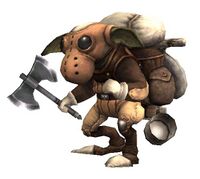Category:Goblins
| Goblins | ||||||||||||||||||||
|---|---|---|---|---|---|---|---|---|---|---|---|---|---|---|---|---|---|---|---|---|
When Goblins are born, linkpearls are inserted, by incision, behind their ears, allowing goblins to communicate with their minds across Vana'diel. The Goblins have a number of different channels, such as those about weather, but they are high frequency so adventurers are unable to hear them. The Moblins of Movalpolos, considered a tribe of Goblin, have evolved sufficiently for them to be considered a different species. | ||||||||||||||||||||
Special Attacks
| Special Abilities | Original and Zilart Areas | Promathia Areas | Aht Urhgan Areas | Wings of the Goddess Areas |
| Goblin Rush: Single target triple attack with Knockback | ||||
| Bomb Toss (1): 8' AOE Fire damage centered on the primary target, deals a set amount of damage. | ||||
Bomb Toss (2): Suicide AOE Fire damage centered on the Goblin, damage depends on Goblin's HP.
|
||||
| Goblin Dice: AoE random effect (Sleep, Slow, Dispel, Disease, Poison, damage, drop TP to 0, Benediction, recharge players' abilities). Only used by Vanguard Notorious Monsters and the Pulling the Strings ENM Moblin Fantocciniman. | ||||
| Saucepan: Replaces food effects in a fan-shaped area of effect. Only used by certain notorious monsters. | ||||
Note: Notorious Monsters in this family may use all of the above and/or additional unique special abilities.
| ||||
Notorious Monsters in Family
Monsters in Family
Historical Background
Goblin
Mythological Background
In French folklore, Goblins were grotesque, elf-like creatures which would often make mischief. They could be playful at times, but are generally evil. It is said their smile could cause blood to curdle, their laugh cause milk to go sour, and fruit to fall from trees. They usually play small pranks, like hiding objects, knocking over bottles or buckets, and altering signposts to point in the wrong direction, but sometimes they would kill people. They lived in old trees (living or dead) and mossy clefts in rocks. It seems as though Goblins originated in France and the Hobgoblin developed in England, while the Bugbear developed in Wales. The English equivalent of Goblins proper were Brownies. It seems they specifically developed in Normandy from Anglo-French culture, which would explain how they got imported from France to England so easily. (Normandy was under English control for a few hundred years. In actuality though, England since 1066 CE has been controlled by the Normans. The territory of England on mainland Europe was lost in 1214.).
Final Fantasy Series Background
Goblins have made semi-regular appearences throughout the Final Fantasy series. They first officially appeared as an enemy monster in the original Final Fantasy, but they were only called Goblins in the the Japanese version of the game, while they were referred to as "Imps" in the original English version (this was corrected in the subsequent remakes of this game that came out years later). Goblins then went onto appear in Final Fantasy II and Final Fantasy III, but their names were unchanged in the English versions, which were only released in English in the forms of remakes several years after their initial releases. Goblins also appeared in Final Fantasy IV, but were again called "Imps" in the original English translations (which was originally released as Final Fantasy II, as it was the second Final Fantasy game to be released to English-speaking audiences). The Goblin was also one of four summons in FFIV that could be obtained through rarely-dropped items from common monsters of the same family. Goblins also appeared in Final Fantasy V and made a return in Final Fantasy VII after their absence from Final Fantasy VI (it should be noted that FFVII was the first time that they were called "Goblins" in the English translation). Goblins later appeared in Final Fantasy IX and again in Final Fantasy XI. Goblins were also absent from Final Fantasy XII, but a monster in the game called Baknamy used the monster's trademark attack, "Goblin Punch".
Goblins are also present in some of the spin-off Final Fantasy titles, including Final Fantasy Mystic Quest, Final Fantasy Tactics, Final Fantasy Tactics Advance, and Final Fantasy Crystal Chronicles.
Characteristically, the weak Goblin looks like a little an elf/gnome with pointy ears and a dagger. Although the Goblins in FFXI have somewhat of a different shorter and stubbier appearence with their face obscured by a mask, their appearence in the game's original concept art looks very similar to that of their predecessors.
Hobgoblin
Mythological Background
In British folklore, a Hobgoblin was a friendly Goblin. It was described as 1-2 feet tall, wearing brown clothes or naked, but completely covered in hair. They lived by fireplaces in houses and rarely ventured outside. They were described as friendly, ugly, good-humored, but mean, playing practical jokes on people. When annoyed, they get particularly nasty. Hobgoblin derives from Robin Goblin, which is derived from Robin Goodfellow, a domesticated, but troublesome fairy in English folklore (Robin here is the pet form of the name Robert). How it got to Hobgoblin was "hobbe" means "elf".
In fantasy games like Dungeons & Dragons, Hobgoblins were rendered as larger, stronger, smarter, more dangerous versions of Goblins, but not as big or strong as Bugbears. Hobgoblins were briefly mentioned in J.R.R. Tolkien's The Hobbit (1937), apparently they were larger and stronger than Goblins. Although Hobgoblins do not appear nor are they described in geat depth, they may have simply been a forerunner to either orcs or Uruk-hai which appear later in The Lord of the Rings (1954-1955).
Pages in category "Goblins"
The following 32 pages are in this category, out of 32 total.
G
- Gambilox Wanderling
- Gibberox Pimplebeak
- Goblin Alchemist
- Goblin Ambusher
- Goblin Bandit
- Goblin Butcher
- Goblin Collector
- Goblin Delver
- Goblin Digger
- Goblin Fisher
- Goblin Gambler
- Goblin Hangman
- Goblin Headman
- Goblin Junkman
- Goblin Marksman
- Goblin Robber
- Goblin Shaman
- Goblin Swordsman
- Goblin Thug
- Goblin Tinkerer
- Goblin Veterinarian
- Goblin Weaver
- Goblin Wolfman
- Goblinsavior Heronox

